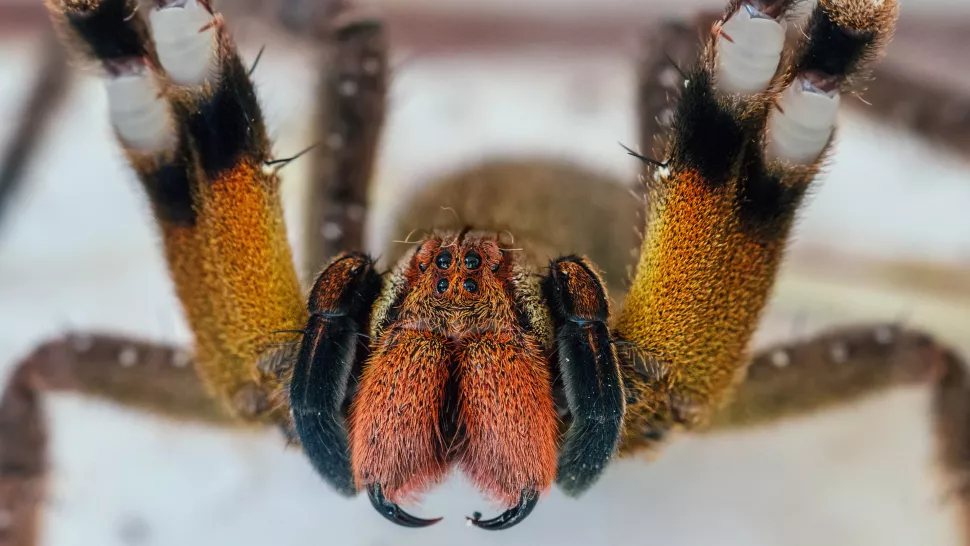

By Titilayo Kupoliyi
Brazilian wandering spiders, also called armed spiders or banana spiders, belong to the genus Phoneutria, which means “murderess” in Greek.
And it’s no wonder why it’s one of the most venomous spiders on Earth.
Its bite, which delivers neurotoxic venom, can be deadly to humans, especially children, although antivenom makes death unlikely.
Brazilian wandering spiders typically live for one or two years.
According to the Natural History Museum in Karlsruhe, Germany, the spiders’ venom is a complex cocktail of toxins, proteins and peptides.
The venom affects ion channels and chemical receptors in victims’ neuromuscular systems.
An arachnologist at the University of the West Indies in Trinidad and Tobago, Jo-Anne Sewlal pointed out, “Classifying an animal as deadly is controversial,” as the amount of damage depends on the amount of venom injected.
Within 30 minutes, symptoms become systemic and include high or low blood pressure, fast or a slow heart rate, nausea, abdominal cramping, hypothermia, vertigo, blurred vision, convulsions and excessive sweating associated with shock.
In addition to intense pain and possible medical complications, the bite of a Brazilian wandering spider can deliver a long, painful erection to human males, Live Science previously reported.
The venom boosts nitric oxide, a chemical that increases blood flow. Several studies have looked at incorporating the venom into drugs for erectile dysfunction.
2008 Article in the journal American Entomologist showed that there are nine species of Brazilian wandering spider, all of which are nocturnal and can be found in Brazil.
Some of the species also can be found throughout Central and South America, from Costa Rica to Argentina.
According to Sewlal, these arachnids “are called wandering spiders because they do not build webs but wander on the forest floor at night, actively hunting prey.” They kill by both ambush and direct attack.
They spend most of their day hiding under logs or in crevices, and come out to hunt at night. They eat insects, other spiders and sometimes, small amphibians, reptiles and mice.
Guinness World Records has previously named the Brazilian wandering spider the world’s most venomous spider multiple times (though the current record-holder is the Sydney funnel-web spider, Atrax robustus, according to Guinness).
However, an arachnologist at the University of the West Indies in Trinidad and Tobago, Jo-Anne Sewlal pointed out, “Classifying an animal as deadly is controversial,” as the amount of damage depends on the amount of venom injected.
Because of the toxicity of their bite and their alarming-looking posture, these spiders have a reputation for being aggressive. But these behaviors are actually defense mechanisms.
“When threatened, they will raise their first two pairs of legs,” Sewlal said. This dramatic and intimidating posture exposes the scarlet hair surrounding the fangs on some species. Their threatened stance serves as a warning, indicating to predators that the poisonous spider is ready to attack.
“Their bites are a means of self-defense and only done if they are provoked intentionally or by accident,” Sewlal said.
In almost all spider species, the female is larger than the male. This dimorphism is no different in the Brazilian wandering spider. Males approach females cautiously when attempting to mate, according to the biology department at the University of Wisconsin-La Crosse. Males perform a dance to get females’ attention, and males often fight each other over the female. The female can be picky, and she often turns down many males before choosing a mating partner. Once she does pick one, the male needs to watch out; females often attack the males once copulation is finished.
The female then can store the sperm in a separate chamber from the eggs until she is ready to fertilize them. She will lay up to 1,000 eggs at a time, which are kept safe in a spun-silk egg sac.
“It is unlikely that the spider would inject all of its venom into you, as this venom is not only needed as a means of defense but to immobilize prey,” Sewlal said.
“So if it did inject all of its venom, it would have to wait until its body manufactured more before it could hunt.” That would also leave the spider vulnerable to being attacked by predators.
Above all, People who are bitten by a Brazilian wandering spider should seek medical attention immediately.
inaturalist.org
Subscribe to our Telegram and YouTube Channels also join our Whatsapp Update Group